KTH helps Nepal shift to cleaner cooking fuels

KTH is part of a collaboration to make Nepalis to use cleaner fuels when cooking.
More than half of Nepal’s population still cook with traditional cooking fuels like firewood and dung. This leads to severe health risks, greenhouse gas emissions, and gender inequality.
A new study by researchers from KTH Royal Institute of Technology, in collaboration with the Clean Cooking Alliance, World Resources Institute, and Nepal Open University, presents a geospatial model to accelerate the clean cooking transition. The study makes use of modelling methods, integrating the open-source clean cooking assessment tool OnStove. This approach allows for the evaluation of different cooking technologies and fuels, maximizing net benefits across each square kilometer of the region, and to designing transition strategies in targeted areas.
New research highlights that by adopting cleaner cooking technologies, like electric cooking, Nepal could prevent around 9,563 deaths annually and reduce health costs and emissions significantly.
The government's subsidy plan could reach 36% of the population, supporting technologies such as improved cookstoves, biogas digesters and electric cookers.
“Electric cooking offers the greatest social and environmental benefits in Nepal,” says Camilo Ramirez, lead author of the study. “Our model shows how targeted subsidies and policies can maximize these benefits and fast-track the transition to clean cooking.”
Launched with the support of Nepal’s Alternative Energy Promotion Center (AEPC), the tool was shared with over 110 stakeholders, including government officials, universities, and local research organizations.
